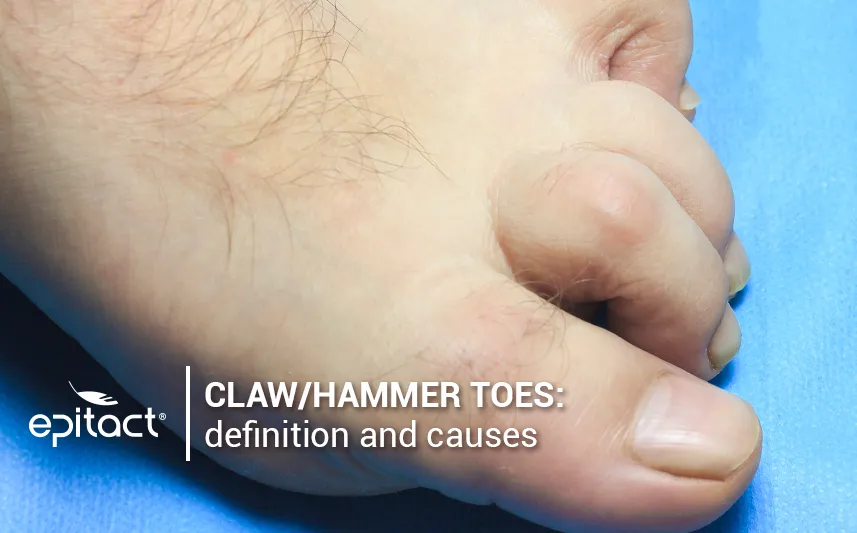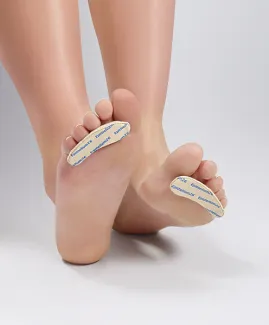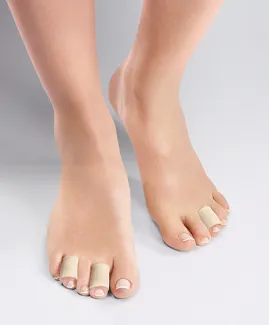
Claw toes, mallet toes or hammer toes are three different deformities that affect the joints of the toes. They are frequently associated with a bunion (hallux valgus) and reduce comfort, especially in the shoes. To relieve pain and re-establish stability, a conservative treatment is generally sufficient. But, in some cases, a surgical treatment is the only option.
First, Let’s discover what a hammer toe is and the differences between a claw toe vs a hammer toe and a mallet toe deformity. Then, find out how they occur and how to treat them with EPITACT®.
What is a hammer toe?
The hammer toe deformity corresponds to a flexion downwards of the first joint of the toe (the middle joint, the farthest to the nail). As a result, the first phalanx named the proximal phalanx is pointing upwards.
Mallet toe deformity
In the mallet toe deformity, the last joint (the nearest to the nail) of the toe bends downwards. As a result, the tip of the toe is flexed towards the floor while the rest of the toe is straight.
Claw toe vs hammer toe
The claw toe deformity combines both a hammer and a mallet toe: the two joints of the toe are flexed downwards so the toe is completely bent over itself.
Swan neck deformity
This is a rare deformity that mainly affects the fingers but it can also concern the toes. The joint at the base of the toe is flexed downwards, the first joint (first interphalangeal joint) is extended and the second joint (second interphalangeal joint) is also bent downwards.
Symptoms & diagnosis of claw and hammer toes
Symptoms of claw toes vs hammer toes are identical and easy to identify. If the toes are deformed, a simple visual examination can confirm the diagnosis. This physical examination is part of a complete medical procedure.
For more details about the degree of the joint deformity, a radiological assessment can be prescribed. It gives more information about the potential damages of the phalangeal joints and their positions in relation to each other. After that, your doctor will refer you to a specialist: podiatrist, rheumatologist, orthopaedist...
The affected joint may become inflamed. The pain, combined with redness, is a typical symptom of inflammation.
With such toe deformities, no matter which one it is, wearing shoes can be difficult and very uncomfortable. The deformed toes rub against the shoe, leading to the formation of painful corns on top of the toes or at their end. Indeed, the skin thickens to protect these areas from rubbing.
If the condition is at an early stage, the toes can still be realigned, that is to say the deformity can be treated. Unfortunately, the more the time passes, the less the deformity can be reduced. If the condition is at an advanced stage, the deformity can cause luxation of the toe: it won’t be able to play its support function anymore.
What is the cause of hammer toes?
Hammer toes, claw toes and mallet toes mainly result from muscle imbalance between the extensor and flexor muscles in the foot.
It is possible to classify causes in two main categories. The first category corresponds to intrinsic factors including structure or posture deformity of the foot (flat foot, bunion...) and extrinsic factors like poor-fitting shoes (avoid wearing high heeled shoes for example).
It is also necessary to look for more general factors like rheumatic or neurologic diseases for example. These factors play a role in the deformity and, if not eradicated, the condition gets worse.
Consequences of bent toes
Smaller toe deformities lead to poor position of the toes. It causes painful pressure areas and then the formation of corns and calluses. Since the toes contribute to the body stability, toe deformities can push the muscle to compensate or can aid the development of other musculoskeletal disorders.
Protecting and realigning claw and hammer toes with the EPITACT® solutions
To relieve pain, realigning the toes that are still moving seems to be the best solution. If these deformities can be corrected, the objective is to give the toes the proper position. To reach this goal, the hammer toe cushions* by EPITACT®are intended to comfortably lie toes down.
Their ultra-smooth fabric makes contact pleasant and provides immediate relief. Held by an elastic band, these cushions can be worn in shoes to reduce pressures and frictions.
If deformities can’t be corrected, wearing corn pads on the painful areas will be useful. The DIGITUBES® sleeves* are made up of a thin layer of silicone that protects the toe and helps corns to disappear.
These medical protective or corrective devices are conservative treatments meant to improve your everyday comfort. Lastly, your podiatrist can suggest a toe orthosis to protect or correct it.
You are numerous to ask what a hammer toe is and what’s the difference between a claw toe vs a hammer toe. Both are deformities that affect different toe joints. Their symptoms and causes help to confirm the diagnosis and to choose the right treatment option.
If the toes are still moving, it is preferable to choose a toe cushion or a brace that realigns the affected toes. On the contrary, if the joint is ankylosed (i.e fixed in a bent position), a protection will be more appropriate.
*These solutions are class I medical devices that bear the CE marking under this regulation. Carefully read the instructions before use. Manufacturer: Millet Innovation. 01/2022
 Pharmacie
Pharmacie
